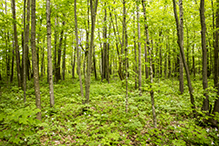Mille Lacs WMA
About • Location • Activities • Ecology
About |
||
Ownership |
||
|
||
Links |
||
Overview |
||
Mille Lacs Wildlife Management Area protects 60.5 square miles of moist hardwood forest and wetlands in east-central Minnesota. About sixty percent of the WMA is forested, mostly moist red oak - basswood forest. The remainder is wetland, mostly sedge meadow and willow - dogwood shrub swamp. There are 80 parking areas and about 100 miles of forest roads, hiking trails, and hunter walking trails within the WMA. Hunters can stalk deer, bear, small game, forest birds, and waterfowl. Fur-bearer trapping is allowed with a permit. Non-game wildlife found here include red-shouldered hawk and four-toed salamander, both species of special concern in Minnesota. Protected plants found here include bog bluegrass, little goblin moonwort, narrow triangle moonwort, and least moonwort. Visitors to Mille Lacs WMA on Memorial Day weekend will see large-flowered trillium peaking and large numbers of mosquitoes feeding. DEET is highly recommended. |
||
History |
||
|
||
Management |
||
Management projects on the WMA include a ruffed grouse management area, a woodcock management demonstration area, and an Adaptive Forest Management Project. |
||
Comments |
||
|
||
Location |
||||
Maps |
||||
Printable Map(s) with GPS coordinates |
||||
Size |
||||
38,729 acres |
||||
Parking |
||||
There are 80 parking areas along the roads bordering the WMA and on Queens Road, Game Refuge Road, 60th Ave., and 50th Ave. Olson Field parking lot WMA Headquarters |
||||
Driving Directions |
 |
|||||
| Mille Lacs and Kanabec Counties | ||||||
| Central Minnesota | ||||||
Activities |
||
Hiking Trails |
||
The are about 100 miles of forest roads and hiking trails within the WMA. |
||
Hunting |
||
Deer, bear, small game, forest birds, and waterfowl. Fur-bearer and minnow trapping available with permit. See Hunting and Trapping Regulations (MN DNR) for details. |
||
Ecology |
|||||||
Ecological Classification |
 |
||||||
| Ecological Province | Laurentian Mixed Forest Province |
||||||
| Ecological Section | Western Superior Uplands |
||||||
| Ecological Subsection | Mille Lacs Uplands |
||||||
| Land Type Association | Ann Lake Drumlin Plain Eastside Till Plain Kathio Moraine |
||||||
Native Plant Communities* |
|||||||
Alder - (Maple - Loosestrife) Swamp Aspen - Ash Forest Black Ash - Yellow Birch - Red Maple - Basswood Swamp (Eastcentral) Bog birch - Alder Shore Fen Central Dry-Mesic Oak-Aspen Forest Central Mesic Hardwood Forest (Eastern) Northern Mixed Cattail Marsh Northern Poor Conifer Swamp Northern Poor Fen Northern Rich Fen (Basin) Northern Wet Ash Swamp Poor Black Spruce Swamp Red Oak - Basswood Forest (Calcareous Till) Red Oak - Basswood Forest (Noncalcareous Till) Red Oak - Sugar Maple - Basswood - (Large-Flowered Trillium) Forest Rich Tamarack Swamp (Eastcentral) Sedge Meadow Willow - Dogwood Shrub Swamp |
|||||||
| * Source: The Minnesota Biological Survey, Minnesota Department of Natural Resources, Division of Ecological Resources | |||||||
Natural Features |
|||||||
|
|||||||

Slideshows |
||

Visitor Videos |
|||
Share your video of this destination. |
|||
| This button not working for you? Simply email us at info@MinnesotaSeasons.com. Attach a video, a YouTube link, or a cloud storage link. |
|||
Other Videos |
|||
| TeamNojTuag Ep.1: Squirrel JVFishy |
|||
About
Published on Oct 13, 2015 ***WARNING*** There is and will be some animal killing in this short clip. For those who can't watch please do not watch this. This is our opener weekend up in Mille Lacs WMA in Mille Lacs, Minnesota. Our family do a yearly opener hunt up in Mille Lacs WMA every year, this year marks our 8th year i believe of being up here and so far this has been the second best year so far. Enjoy the clip and subscribe for more hunting video coming. The next Episode will be on our second duck opener weekend. |
|||


Created: Last Updated: © MinnesotaSeasons.com. All rights reserved. |




























